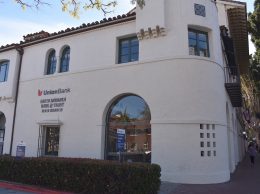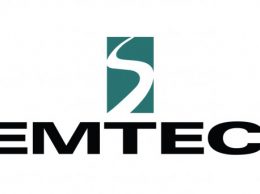Sale of SBB&T means end of an era
IN THIS ARTICLE
- Banking & Finance Topic
- Stephen Nellis Author
By Stephen Nellis Friday, March 16th, 2012
EDITOR’S NOTE: This is one part in a three-part package on Union Bank’s acquisition of Pacific Capital Bancorp, the parent of Santa Barbara Bank & Trust. Read the other two stories here:
- “Union deal rattles region’s banks.” A look at the key players in the banking landscape as the largest independent bank in the Tri-Counties prepares to exit the scene.
- Recession, mergers and the future of finance. Pacific Capital was the last large independent banking firm in the region.
“The staff of Santa Barbara’s newest bank, The Santa Barbara National, extends a very cordial invitation for you and your family to visit on opening day, tomorrow. Every guest will draw ‘merchandise samples’ from the treasure chest. So, drop in tomorrow … meet the friendly people who staff Santa Barbara’s Only Home Owned Bank.”
Now yellowed with time, the full-page advertisement appeared in the March 17, 1960 Santa Barbara News-Press. It depicts 18 staffers. A few titles recall a bygone banking era.
Norman Lord, the silver-haired gentleman decked in business suit and tie, is listed as “Parking Lot Attendant.” Frances Tarchine, the spunky young lady who ran a newfangled machine, is listed as “IBM Operator.” In black and white, everyone looks sharp. Two women wear horn-rimmed glasses. Among the men reign the clean, flat-top crew cut and the unmistakable sheen of Brylcreem.
Five days shy of 51 years later, the news comes that the name, changed to Santa Barbara Bank & Trust after a shift to a state charter, will be gone by 2013, replaced by the name of its acquirer, Union Bank.
“It’s like an old family member passing away,” said Irwin Pomerantz, who has been a shareholder in the bank, now under holding company Pacific Capital Bancorp, since it opened in 1960.
Pomerantz, 83, is an accountant in Los Angeles. He became familiar with Santa Barbara during the Korean War, when his California National Guard unit was activated. He trained at what is now Vandenberg Air Force Base with members of the family who owned Ott’s Hardware in Santa Barbara.
As a business person, Pomerantz understands Ford Financial Fund’s decision to sell to Union Bank for $1.5 billion. Financier Gerald Ford took a big risk, turned the bank around and was offered a good price. But ceding control to Tokyo and consigning the Santa Barbara Bank & Trust name to history books left Pomerantz, like many longtime shareholders, feeling stunned. “I don’t know, truly, whether to be happy or sad. It’s kind of confusion,” he said.
“I have, with great pride, retained that ownership.”
Back in 1960, Louis Lancaster, Ralph Raddue and Reuben Irvin founded Santa Barbara National Bank with about 800 initial shareholders, many of them Santa Barbara business owners. Customers chatted on a first-name basis with their bankers. Tellers stashed dog biscuits behind the counter (Some still do). Pacific Capital built the first drive-through bank counter in Santa Barbara and became a staple of the business community.
For the next 35 years, Santa Barbara Bank & Trust remained planted in Santa Barbara County. It did not branch into Ventura County until 1995. It did so only when the third generation of founders at the Bank of A. Levy, Ventura County’s dominant bank, sold the institution to First Interstate Bank. That ended the decades-long handshake deal under which Bank of A. Levy and Santa Barbara Bank & Trust refrained from encroaching on each other’s turf.
In 1998, Santa Barbara Bank & Trust merged with Pacific Capital Bancorp, the holding company for First National Bank of Central California and South Valley National Bank. Its footprint spread into Monterey, Santa Cruz, Santa Clara and San Benito counties. There followed deals in Ventura, Los Angeles and even San Diego counties that swelled the bank’s ranks to more than 1,300 employees and its balance sheet to more than $7 billion in assets.
“We doubled in less than 10 years as far as asset size was concerned,” said Fred Clough, who joined Pacific Capital Bancorp in 2001 and served as general counsel.
Some insiders believe those deals were mishandled, particularly the “merger of equals” approach that Santa Barbara & Trust took toward its northern neighbors. These insiders believe the bank reached too far and lost sight of its purpose — a financial institution owned by, and obliged to serve, stakeholders in Santa Barbara County. They didn’t understand why the bank should make loans on properties in Bakersfield, the San Joaquin Valley or Nevada.
“They didn’t make very wise acquisitions,” said Roy Gaskin, a retired veteran of the bank’s wealth management division. Beginning in the late 1990s, “Management didn’t do its job, which they were more than adequately paid for.”
In particular, the bank’s leaders squandered tens of millions of dollars in a botched attempt to integrate the computer systems of the northern and southern parts of the institution.
Cash for the acquisition spree flowed from profits on Santa Barbara Bank & Trust’s refund anticipation loan program, or RAL. It acted as a payday loan business for people expecting a tax return. Santa Barbara Bank & Trust didn’t finance the program from its balance sheet. It borrowed or took in short-term CDs instead, pocketing the margin spread. The program drew scrutiny from consumer groups. Its profits masked operational inefficiencies at the bank. And its shady flavor troubled legacy-minded shareholders. After generating hundreds of millions of dollars for the bank, sold for $10 million in a fire sale after being nearly banned by the IRS.
Clough said the program did not bring down the Santa Barbara Bank & Trust name. Instead, he said, the economic downturn torpedoed real estate values, and Pacific Capital sank with them. The refund anticipation loan program “played a major role in the expansion of the bank over time because it was a big revenue generator,” Clough said. “I don’t think the problems the bank struggled with in the last couple years before the infusions of capital from the Texas investors related much to the [refund loan] program. It was basically a problem with the commercial and real estate loans.”
Longtime shareholders stand to lose big. Carroll Pruett, who served as CEO of Arroyo Grande-based Mid-State Bank & Trust from 1967 to 2000, said he “picked up a pretty sizeable chunk” of his former competitor. Mid-State was sold to Rabobank in 2007 for $857 million.
Former Pacific Capital President “Dave Spainhour and I used to kid each other that the first one of us who goes, the other will have the best franchise in California,” Pruett said. “Unfortunately, us smaller shareholders rode Santa Barbara Bank & Trust right to the bottom. I don’t think I’ll get much.”
Pomerantz, the Los Angeles accountant, said he owned more than 15,000 shares at one point. His holding dwindled after a 100-for-1 reverse split.
The $46 a share from Union Bank means little to him. Long ago he planned to pass on his Santa Barbara Bank & Trust stake to a son who lives in Santa Barbara County. “My kids all knew they were going to have stock in the bank because I was going to give that to them,” he said, “but now, no more.”
Related Articles
 Monday, July 25th, 2022
Monday, July 25th, 2022










